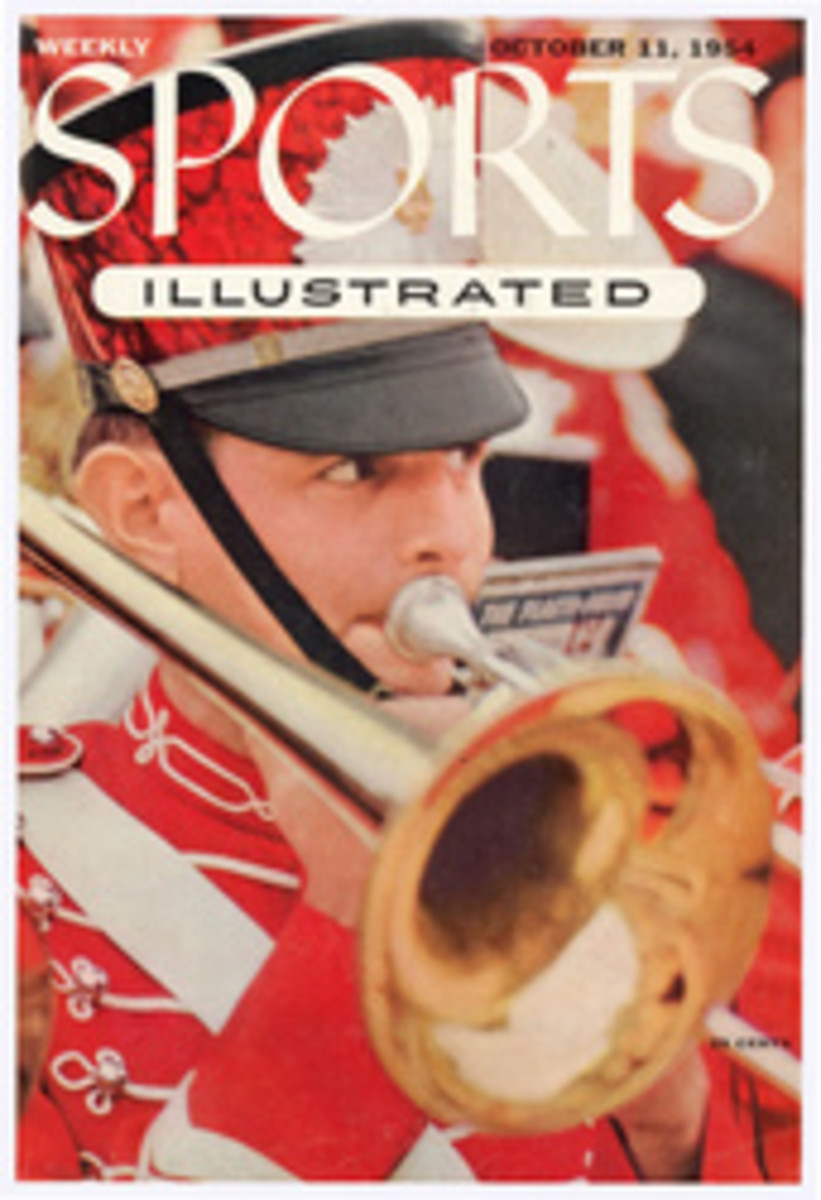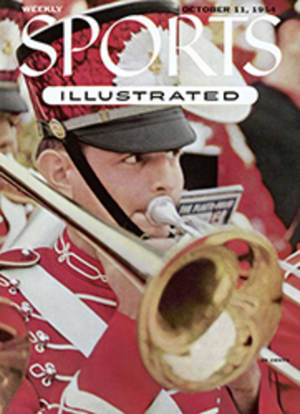
LISTENING TO THE FOXHOUND
Hunters in Troy, Mo. last week released 303 hounds in pursuit of game that the hunters candidly hoped their dogs would not be able to catch.
The quarry was the red fox, a smelly little animal that is no good to eat and not worth much for his fur—but invaluable to men who run him with dogs because he has excellent running gear, is cunning and even seems to like to be chased by hounds.
The hounds were American foxhounds and the occasion was the 15th annual field trial and bench show of the Midwest Fox Hunters Association, the first big trial of the fall season. The hunters were horseless and there was not a pink coat among them. This was fox hunting Midwest style, with serious-faced farmers, denim-and wind-breaker-dressed, meeting at dawn on dew-soaked ground to pit their hounds against each other. Their purpose: to determine whose dog this day had the right to be called "best."
None of this—in Midwest-style foxhunting trials—required "riding to hounds," cries of tally-ho or the running of a fox to ground. All that was necessary was a live scent and live hounds in good voice. Once the dogs set off on the search, the hunters settled themselves and cocked their ears to enjoy the chief aim of Midwest fox hunting: listening.
To the east a hound was crying fox. In silence the hunters stood listening, straining to identify the voices of their own hounds in the baying pack. In pick-up trucks and cars they sped to hilltop vantage points the better to hear the action. Only after hounds were out of hearing did the men break silence and praise and claim the "mouths" of their dogs with pride and authority. Then off to another point closer to the pack—now working the fox hard—to stand again in muted assemblage to hear that singing of dog voices which is music to a houndman.
Out in the 5,800-acre trial area of Cuivre River State Park, the dogs were left alone to hunt and drive for fox, unaided by the hunters but watched closely by 14 judges who scored and marked them for their ability to work and hunt.
100,000 NIGHT-HUNTERS
The English tradition of fox hunting is today carried on by a few hundred hunt clubs who ride to hounds for the joy of the chase on horseback, but the main body of the sport are the 100,000 night-hunters stretched across 25 states from the eastern seaboard south of Chicago to Texas—chiefly farmers with packs of 12 to 15 hounds, which they hunt at night for the pleasure of hearing the dogs giving tongue after a fox. Wherever men of the land have kept hound-dogs, there have been arguments and contests, not about men and their ability to ride a horse after hounds, but about the dogs and which was the better hunter.
As early as 1866 hound contests were held in Kentucky and by 1889 arguments had waxed loud and long enough for the first organized field trial to be staged at Albany Hills, Maine. Slowly the sport of hunting hounds in competitive trials grew until in 1893 the National Foxhunters Association was formed. It is the association's National Championships which climaxes the season's sport now opening.
There had been good rain at Troy last week, and conditions were perfect. At the bench show preceding the trial, Tony Trigg III went best-in-show and School Girl best of opposite sex. They were bred and shown by Herbert O. Lamb, of New Albany, Ind., whose kennel produced last year's national bench champion. After three mornings of hard running in the field trials, Bobo Goodman, entered by Ed Wallach of Eureka, Mo., was named Midwest field champion, and Kate, owned by Spencer Morris of Stockport, Iowa, won the derby field, for hounds whelped after Jan. 1, 1953. Combination field and bench honors went to Faultless Hi Sailor, entered by Leo Schneider of La Crosse, Wis.
In the Midwest version, fox and hounds are seldom seen together, since the fox usually moves at least 100 or 200 yards ahead. The fox is seldom seen by the onlookers, who more often get to a crossing just after the fox than just before, and have the frustration of being told by someone, "You should have been here—he crossed just a moment ago."
This unlikely way of hunting has the virtue that the same animal may be hunted many times.
THE TREASURED FOX
The fox seems indeed to like to be chased, for a fox will often run six or seven hours, then lose the hounds completely in a maneuver that could just as well have been made hours earlier. Hunters often get "pet" foxes, foxes whose running habits are so consistent and distinctive that hunters know they are running him time after time.
The pet fox runs well, as a result of experience, and is practically a guarantee of a good race. Hunters treasure him. They view his inevitable passing with as much regret as that of a good hound.
PHOTO
HY PESKIN
PHOTO
HY PESKIN
BY DAWN'S EARLY LIGHT-AND AUTO HEADLAMPS-JUDGES CHECK DOGS BEFORE TRIALS
TWO PHOTOS
HY PESKIN
HUNTERS AT TROY, MO. FIELD TRIALS STAND READY TO UNLEASH HOUNDS WHICH BECOME A CHARGING BLUR OF BLACK AND TAN AND WHITE AS CAST IS MADE (BELOW)
PHOTO
HY PESKIN
BOUNDING HOUND, released at start of trials and off in search of a scent, is closely followed by judge in auto until trail leads off into the fields.
PHOTO
HY PESKIN
A BOBBLE, or bother, is what huntsmen call momentary check when scent is lost.
PHOTO
HY PESKIN
MOUNTED JUDGES watch but do not aid dog trying to pick up fox's tracks.
TWO PHOTOS
HY PESKIN
AFTER FIVE-HOUR HUNT, FOOTPAD SORE AND WEARY, DOGS REST UNTIL TOMORROW
HUNTER & HOUND TALK
Fox hunting, night style, borrows a term or two from English tradition but also employs many of its own. A short glossary:
Babble: To give tongue without having scented a fox. Bad trait.
Backtracking: Running the line of scent in the wrong direction—toward where the fox came from. Cardinal sin.
Blowing off the hunt: Calling in the hounds, usually with horns made from cattle or goat horns, at the end of hunting.
The cast: The act of releasing hounds for a day's running.
Cry fox: To bark in characteristic announcement of the scent of fox.
Cutting: Some hounds learn to anticipate the fox and leave the line of scent, taking a short cut to where they think the fox will go. Another cardinal sin.
Giving tongue: To the uninitiated, more barking; to the hunter, the pulse-quickening music of hounds in pursuit.
Harking in: When a hound running alone catches the cry of a pack, rushes to join it, giving tongue.
Sight race: That rare chase in which hounds actually see the fox.
Hound talk: Hounds have their language too, understood by hounds, hunters and the fox. Hound voices—mouths, the hunters call them—come coarse and fine, and all shades between. Hounds bawl, chop and squeal, sometimes bay, according to their lights, but never "bark;" at least not out of the kennel. To be appreciated fully, hound voices need to be heard in chorus.

